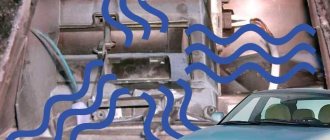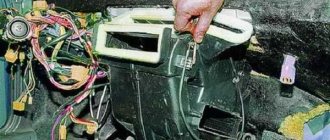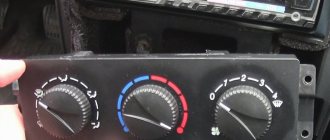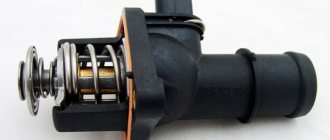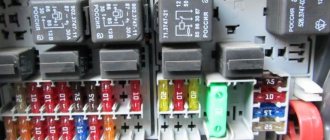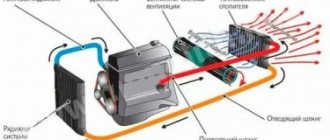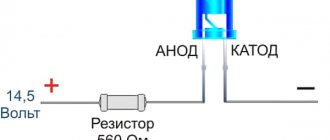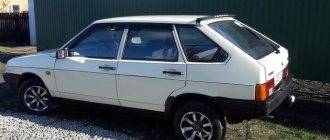In the winter months, you need to find out why the stove is not working and cold air is blowing on a Priora (or other domestically produced car) as quickly as possible. Of course, you won’t turn into ice and don’t risk freezing anything. But driving with the heating not working is, at a minimum, unpleasant and fraught with all sorts of colds.
And driving out onto the highway is completely dangerous: God forbid, something breaks, you will really freeze until help arrives. Priora is the generally recognized descendant and successor of the Lada “ten”.
And the manufacturer did not make any fundamental design changes to the stove; only individual elements were changed. Accordingly, the diseases inherent in the ancestor were inherited by the descendant. All Priora owners unanimously assure that the heating system in it is very unreliable and can break down in several components. The worst thing is that in the summer few people remember about the stove and are puzzled by checking it. Therefore, discomfort is detected suddenly and requires lightning-fast action.
Content
Why doesn't the heater work and blows cold air on the Priora? There are many reasons for this. In descending order of frequency of cases, they can be arranged as follows:
- The stove damper is stuck. It does not open and does not allow warm air into the cabin. By the way, the opposite option is also possible: if it is closed in the open position, you begin to feel like you are in a sauna;
- The heating gear motor is broken;
- The stove control unit does not work;
- Problems in the engine cooling system;
- The temperature sensor in the cabin has broken down, and the heating system simply does not know that you are cold. Again, in a similar but opposite case, it may be hot.
Gearmotor repair
In most cases, the extraneous sounds produced by the heater damper drive on a Priora are associated with cracking of the plastic gear. When its teeth are cut off, the mechanism stops working normally. Replacing it is quite difficult, but possible. After dismantling the gearbox, release the compressed plastic cover and bend it, then carefully remove it.
After carefully inspecting the mechanism, determine which gears are faulty and install new ones. Determine the condition of the commutator, bearings and brushes of the mechanism. Lubricate the bearings with silicone grease, which does not harm other structural elements. If after assembly the system functions normally, replacing the heater gear motor will not be necessary.
Clogged filter
Experienced Prior owners have developed an algorithm of actions to find out where the heating system is leaking.
First approach
Before all checks, you need to make sure that the fan is working - it would be unreasonable to go deeper if the main element does not spin. The next steps are as follows.
- The engine heats up to the desired temperature;
- The pipes leading to the heater are probed. Both are hot - okay, one is at ambient temperature - which means there is no filler circulation;
- The hood opens, the tap is located and turns to another position. If it gets stuck, you will have to immediately soak it with WD-40.
- The system is checked for leaks. The detected ones are eliminated: a constant lack of coolant is also the cause of cold airflow;
- The tap is working, there is no leak - the plug is removed from the tank and the liquid level is checked. Often an air lock forms in the tank; in this case, the coolant is topped up to normal, and the gas pedal is pressed sharply several times. The fluid circulation will resume and squeeze the plug out of the reservoir;
- To make the last step more effective, it is better to drive the front end onto the nearest hillock so that the car’s radiator is lower than the stove radiator.
Second approach
When (or if) both pipes are filled with hot liquid, we move on to the dampers.
- Again you will have to climb under the hood, this time to observe the operation of the damper;
- If it is warped or jammed, you can try to gently shake it with your hand from inside the cabin. To do this, remove the central deflector and unscrew the plastic guides to reach the stuck element. Access is only possible for a thin limb, so it is advisable to invite a female person to the procedure if she does not mind;
- If there are serious problems with the damper (the fastenings have rusted, the plastic has warped due to temperature or it has cracked), alas, you will be faced with difficult work: you will have to disassemble half of the heating system.
Third approach
The microreducer is a complete headache. First, its status is checked:
- The left handle is moved to the “min” position. After a 15-second wait, the engine starts;
- The controller that monitors the self-propelled guns is disconnected;
- The tester measures readings
on both contacts. The resistance should be 800-1200 Ohms for units 1303.3854; 1313.3854 and 1333.3854; for controller 1323.3854 the norm is 3600-5000; - The same operation is carried out in the “max” position. Now the data is in the range of 3200-3500 for the first group and 1200-1600 for 1323.3854;
- If there is no resistance or its unchangeability, the track on the sensor has been erased. It is not sold separately, so you will have to change the entire MMR. It is clear that not all the reasons why the stove does not work and cold air blows on a Priora can be eliminated on your own.
Recommendations
Comments 42
He’ll overlook the antifreeze) so the first reason is the green thing... If necessary, I’ll write about it a little later
Thanks, I'll wait
And so, if the gearmotor is in working condition and does not jam, then the problem is with the Additional heater resistor. It is when this thing fails that hot air stops flowing into the cabin. On my Priora, the gear motor broke at one time, the characteristic sound of its operation was not heard... after replacement, everything was normal. The guy on the luxury Prior also had a problem with hot air, but he got around it by adding antifreeze, the pipe was leaking. Another friend had this problem, and it was his resistor that burned out. So first test the gear motor, if that’s not the problem, then change the resistor. They are located close to each other. Here is a link to the structure of the Priora stove, which was the first one I came across. Number 6 is that ill-fated green thing in the color picture)))) club-lada.rf/priora-remont/220-pechka-priora.html
Thanks a lot! I decided not to climb myself, I’ll go to the station.
The first reason is to check the antifreeze level. Next comes the damper gear motor, if when you turn the knob that switches hot cold air you can’t hear it working, then it’s it. If it switches, then the problem is (I don’t remember exactly what this green thing under the hood in the stove body is called), but it is this thing that is responsible for the hot air.
look at the pump, it's probably leaking brains
Perhaps it was the pump I had like this, the impeller fell off and turned, it was also blowing cold, I dismantled the stove, changed the gear motor, radiator, and then as it got warmer the car began to warm up, I changed the pump and that’s it Tashkent
I'm not inclined towards the pump. I’ve been driving like this for a year now, I think it would prove itself in the summer...
Class! Thank you! Maybe I'll change it today!))))
Option 1 - the problem is in the gear motor gear, it does not turn until it warms up. Option 2 - the problem is in the temperature sensor in the ceiling, it is this that regulates the position of the heater damper, depending on the temperature in the cabin and the desired temperature on the regulator. If you turn off this sensor, then the position of the damper will correspond to the position on the regulator.
It doesn't need to warm up to turn over. It is already lubricated with lubricant in a sealed housing. There’s nothing special for her to warm up there. It won't turn if its teeth break. Desynchronization of the position of the damper and the control knob occurs precisely because the sensor sends a signal to an already obviously broken regulator. A gear with broken teeth jumps over normal ones. Over time, the next teeth will break, and as a result an unpredictable wedge
Are you treating from photographs?
necessary, not necessary - the fact is the fact that the damper turns only when the engine is warmed up. What prevents the gear motor from rotating until it warms up? and it rotates... not immediately, but much later - which means warming up is important. and if it had been teeth, it would have turned right away. without waiting for it to warm up. A gear with broken teeth jumps over normal ones - complete nonsense. disassemble the gear motor at least once. the teeth there do not break, but the edges are eaten away and that is why a wedge appears.
There is no desynchronization between the handle and the sensor; it contains the principle of a constantly adjusting heater damper, based on the readings of the interior temperature sensor. Let’s say we want 20+ and we have 12, then the gear motor will open the damper as much as possible, then as the interior warms up, as it warms up it lowers it to a position in which the flow of hot air will maintain 20+ in the cabin.
not from the photo, but from experience, I myself changed 3 of these gearboxes; all of them had 3 broken teeth on the selector gear, I took them apart and saw how they were arranged inside, the teeth were broken, not ground off. The gearbox does not need heating to operate. The gearbox starts moving as soon as you start the car - IMMEDIATELY look for a new position from the one in which it remained before turning off, taking into account the changed weather realities, as shown by the sensor in the cabin. It moves immediately, without warming up. And if you left it at 20+ and it’s -10 outside in the morning, then in order to heat the solon again to 20+, the damper will start from a different position, immediately setting it to 20+ and not the maximum, this is not required of it. And it will begin to move slowly after the interior has warmed up to 20+, reducing the warm air, thereby maintaining 20+. And it is during the initial start-up that the teeth in the gearbox break - for what reason - that’s another matter, wear there or a high starting current or something else. When 1 tooth is broken, it’s not scary, but when 2 or more are broken, it begins to jump or slip, causing a mismatch between the position of the damper and the control knob, and when, for example, you want heat, the lack of teeth does not allow you to move the damper to this position. So disassemble the gearbox yourself, just break 2-3 teeth, rotate the broken gear against the whole one and see how a discrepancy arises. As a result, the broken gear will take such a position that neither the manual control nor the sensor will move it.
Heating system elements (stoves)
The fact that the Priora stove is 95% similar to the “ten” can be seen by the catalog numbers:
- Heater assembly (2170-8101012 or 2111-8101012-10).
- Air flow distribution gearmotor (2170-8127100). Distributes air flow to the feet/face/windshield. Located inside the dashboard.
- Interior air temperature sensor (11186-8128050). Located on the ceiling.
- Heater control controller (HCU) or stove control unit (21703-8128020). The block on which the driver sets the operating parameters of the stove. Located on the panel.
- Additional resistor or additional resistor (2123-8118022). Determines the rotation speed of the stove fan. Secured in the engine compartment.
- Electric heater fan (2111-8118020). Located under the hood.
- Heater damper motor reducer (2110-8127200). Distributes air flows into the cabin (outside/heater radiator). Inside the heater assembly.
- Air filter (2110-8122020).
- Heater radiator (2110-8101060). Located inside the heater.
A malfunction of one of these elements causes problems in the operation of the stove.
Preparatory stage
Troubleshooting the heater should begin provided that the power unit and engine cooling system are in order to eliminate their influence. To do this, you need to make sure that the antifreeze is poured in the proper amount, the engine is in good condition and is functioning normally. And after that, find out why the stove on the Priora does not work. First, check the coolant level in the expansion tank. Next, you need to start the engine and warm it up to operating temperature. After this, you need to check the serviceability of the thermostat - feel the thick hoses that go from it to the car radiator.
The top one should gradually become hot. If the rubber hose is still cold, the thermostat is faulty. In this case, you can continue working only after replacing this element. Fortunately, its cost is low.
Another reason why the engine may not warm up to operating temperature is a leaky expansion tank cap. It should keep excess pressure in the system. Often, simply replacing this cover can completely eliminate the problem.
On the Priora, unlike the Tens, the cooling system is organized differently. And the formation of an air lock there is practically excluded. It can occur when the system is leaking or when antifreeze is poured into a completely empty expansion tank. This can be fixed quite simply. You need to drive your front wheels up some hill in a warm car and vigorously apply the gas in place. The expansion tank cap should be removed.
Operating principle of the stove
To independently determine a heater malfunction, you should understand the principle of its operation.
The heater control controller receives a signal from the temperature sensor in the cabin and compares it with the temperature set by the driver. If there is a difference, then the KUO sends a signal to the heater gear motor (located under the hood) so that it closes or opens the heater dampers by a certain amount for a greater supply of cold or hot air.
After setting the required heater fan speed, the heater control controller sends a signal to an additional resistor (in the engine compartment), which, due to the built-in resistance, sends an adjusted signal to the fan. At maximum speed, the resistor is not used and the electric fan rotates at maximum speed.
The air direction (face/legs/windshield) is determined by the driver by setting the required value on the control unit. After this, the signal is sent to the air flow distribution gearmotor (inside the panel/dashboard), which moves the flaps in the desired direction.
Heater radiator malfunctions
Another reason why the heater in a Lada Priora car does not work (cold air blows from the deflectors) may be the accumulation of dirt in the heat exchanger. When the cooling system operates, deposits accumulate in the engine block itself over time, which are then spread throughout the entire system, including into the heater radiator. These deposits prevent it from working effectively. The system will heat the air worse. In this case, the heater radiator can be replaced entirely. It is removed from the engine side. Before starting work, be sure to drain the antifreeze from the cooling system. Then dismantle the windshield wiper arms, the frill trim and move aside part of the soundproofing shield. After this, disassemble the stove body, disconnect the wires, remove the fan motor along with the impeller and remove the heat exchanger, disconnecting the supply hoses from it.
If the stove blows cold air (does not heat)
There may be several reasons why the Priora’s stove does not heat well (the percentage of breakdowns based on the results of a survey among owners of this car is indicated in parentheses):
- There is a malfunction in the engine cooling system (the heater radiator is cold and cannot give off heat). Touch both heater core hoses; they should both be hot. Sometimes the reason lies in the radiator itself (defect, insufficiently productive) (8%).
- Dirty cabin filter. Try removing the filter for a while and checking the operation of the stove (2%).
- The heater damper does not work, it is simply jammed (17%).
- The heater gear motor is faulty (16%).
- The heater control unit is faulty (13%).
- The interior air temperature sensor is faulty. Try turning it off for a while and check the operation of the heater (6%).
Only speeds 1 and 4 work
Often such a malfunction occurs when the stove switch gives a command only in the extreme positions. The cause of breakdown is often additional resistance, which reduces the rotation speed of the furnace device.
The resistor is a block where the fourth speed is direct and without retardation. The device is located in the heater housing on the left and is secured with a pair of screws.
In a situation where the first three positions do not work, and only the 4th one functions, the cause may be a broken resistor (mentioned above) or a failure of the heating and ventilation system control unit. The last malfunction is more common.
The elements responsible for the operation of the Lada Priora stove are shown below.
Possible reasons for cold air supply
A common situation is when cold air blows from the Priora stove; there may be more than one reason for this. It is in identifying the malfunction that the main problem lies. There may be several reasons why the stove on a Priora does not blow:
- A breakdown of the engine cooling system is the most common problem. This is where diagnostics should begin. In most cases, the stove on a Priora does not turn on precisely for this reason.
- A heavily dirty cabin filter that should be replaced with a new one. This procedure should be performed every six months, without waiting for the moment when the stove starts blowing cold air.
- The stove on the Priora is not blowing well, possibly due to the damper, which may be stuck. It may not open completely, thus blocking the path of hot air flows.
- The problem may also lie in the gearmotor. It is necessary to check its functionality.
- If the stove on a Priora does not work as you would like, then you should pay attention to the control unit.
- The temperature sensor can also have a negative impact on the performance of the heating system. To determine this point, you will need to turn off the sensor and see how the heater behaves.
Recommendations
Comments 19
A month ago I solved this problem for myself. True, I had to tinker. You will still have to remove the motor. But first, check the snail itself through the hatch in the control compartment for foreign objects. If everything is clean, then try turning on the stove and turning the impeller by hand. But most likely it will have to be removed. Removal option 2. Disconnect the condenser or not disconnect it. You can't just stick the motor out there. Using a grinder, I carefully cut the plastic from the air conditioner pipes up and removed the left side of the plastic. The snail came apart easily, I fiddled with the motor a little.
It was the same story, a blow to the stove still turned on the motor, but for the time being. Then he stopped completely. The brushes on my fan motor are worn out. This is a very troublesome problem, if according to the instructions, the repair is very expensive, since it is necessary to remove the entire climate control unit from under the hood (drain the air conditioner, frieze, etc.) But there is another way, you will have to cut the plastic trim of the engine compartment in two places to get it out motor, brushes can be bought for about 500 rubles, I bought some for a foreign car, they fit best. If you’re interested, I can tell you in more detail) I myself spent a very long time and persistently cursing at AVTOVAZ’s designers when I was doing all this.
It will be useful: Adjusting the valves of grant frets 8 and 16 valves with your own hands: video instructions
try to look at the chip under the frill of the driver's wiper. I had the same problem due to overheating and loss of contact in this chip)
Today I’ll take a look and see what the chip is on the driver’s side, i.e. so far from the motor itself?
yes, on the driver's side)
The brushes in the electric motor may jam. If after knocking it starts working, this is the first sign.
When knocking, the motor does not come to life... I tried it, it didn’t help...
It was so. The chip that goes to the fan motor melted. Replaced the connector. All is good. And it also happened that the knock would work. Since it was a bitter winter, we started looking at the first opportunity.
A friend had this happen. The negative wire came off, there was no contact + there are three problems with the motor itself, the switching resistor. look at the diagram, check the voltage. Did it go to the block, then to the motor?
Directly check the motor by applying power to the connector, and then based on the results. Is there a condo?
To apply voltage directly to the motor, do you need to remove the black plastic under the wipers? Priora with Conder
We carry out comprehensive diagnostics
Removing a faulty heater from a Lada Priora is not so easy. Even experienced motorists cannot cope with this task quickly. To avoid doing such a large amount of work in vain, it is better to first diagnose the heating system. You must proceed as follows:
- We probe the channels through which the coolant flows to the heater. They should be warm when the stove is on. In addition, when pressing on the main rubber hoses, resistance should be felt. If resistance is not felt, the pump pump may be faulty. This mechanism is responsible for creating the pressure of fluid flows necessary for normal operation of the heater.
- A little secret that may be useful to Lada Priora owners: does the stove blow cold air for a long time and does not warm up as quickly as we would like? Then you can try filling coolant to the bottom mark in the tank. In this case, the liquid will warm up faster. If you practice this method, you will need to constantly check the coolant level.
- If a running heater is a source of noise, then we can talk about a problem in the bearing, which is located on the electric fan. This situation cannot be ignored, since in the future the fan may jam and repairs will take place on a much larger scale.
- Is the stove not working? Perhaps the problem is hidden in fuse F9 with a rating of 25 A. Its function is to protect the power electrical lines of the heater. A blown fuse must be replaced. If such a situation occurs with enviable consistency, then it is necessary to check all electrical circuits of the heater, the insulation of the windings on the fan and the presence of an overload in the power circuit.
No heating at idle
It is not for nothing that this issue has been submitted for separate consideration, since it worries many motorists and solving the problem can be much more difficult than one might expect. So, you have a Priora, the heater does not heat up at idle, although when the car is moving, the interior is heated in normal mode. Here you can also identify several possible reasons:
- Insufficient coolant level.
- Leaks that lead to a decrease in antifreeze levels.
- There is an air lock in the system.
If the first two problems can be easily diagnosed and eliminated, then with an air lock the situation is much more complicated. If you have ruled out the first two reasons and the Priora’s stove still does not heat up at idle, you need to eliminate the air lock. You must proceed as follows:
- We remove the screen from the engine.
- We lower the clamp, after which it is necessary to remove the heating tube for the throttle assembly. We choose any of the two.
- Unscrew the cap on the expansion tank. We place a clean rag on the neck and begin to blow into the expansion tank. The air supply should be carried out until coolant begins to pour out of the tube, which was previously removed.
- Immediately place the tube on the fitting and carefully tighten the clamp.
- Installing the screen.
If the option of blowing out the tank does not suit you, then you can go another way. We warm up the engine so that the pressure in the heating system increases. After some time, we turn off the car and remove the hose from the heating of the throttle assembly. In this case, there is no need to remove the cap from the tank. As a result of high pressure, coolant will be forced through the tube. All that remains is to place the tube on the fitting and tighten the clamp.
Now the Priora stove should not cause any difficulties; you know how to fix faults, as well as carry out diagnostics and identify the source of the problems. Let the heater in your car always turn on, work properly and provide comfort regardless of the weather outside.
What to do first
In order not to get buried in the abundance of reasons, it is necessary to act from simple to complex. Leave the frightening thoughts of a broken cylinder head gasket and take a trifling attitude, as if the electric damper actuator has failed. Actually, that's where we'll start.
Check the operation of the climate control shutters
Turn the knob or rocker of the climate system and evaluate the temperature of the incoming air. For example, with “blue all the way” the air should be noticeably cold, and with the maximum red settings it should be warmer.
Immobilized valves will not be able to mix flows according to the specified °C value. Therefore, at any position of the regulator, air will blow at the same temperature. The dampers stop as a result of damaged fasteners or a failed servomotor.
Attention. If the cooling system has a tap installed on the stove, check its position. Must be open.
Is the antifreeze level in the expansion tank stable?
Lift the hood, find the “extender” and the boundary marks on it. When cold, the antifreeze level should be between the MIN and MAX marks. If the tank is constantly emptying, look for leaks. You can look at where the coolant goes using the Lada Vesta as an example.
Heater radiators of some cars, for example Lada Kalina, are very sensitive to the amount of antifreeze in the expansion tank. At the slightest leak, the engine heats up, and the stove is cold or barely warm. And in general, when liquid flows out, air comes in and thus the system becomes airy.
Advice. It is better to look for small leaks under pressure. For example, adapt a regular spool valve from the chamber to the “expander” and create pressure in the tank with a bicycle pump.
Inspect the heater radiator for unobstructed circulation
Find two pipes going to the heater heat exchanger near the engine shield and touch them. The radiator assembly is embedded in a small circle in parallel, which means that the hoses should warm up immediately after starting the engine. It is better to carry out work when the engine is warmed up.
If one of the tubes is cold and the other is warm, the radiator is clogged or airy. First, rule out the presence of a dirt plug: pull off the outlet hose and evaluate the flow - practically nothing will flow out of a clogged radiator installation. Isn't that the point? Then feel free to expel the air.
How to remove an air lock without draining the coolant
It happens that if there is air in a small circuit, the temperature sensor on the dashboard behaves strangely: the needle sometimes jumps. For example, it was at 60°C and instantly became 90-100°C, then returned back. This is explained by the fact that the air heats up noticeably faster than the liquid and to higher temperatures. As a rule, the needle twitches when the system is seriously aired.
Features of the heater in a Priora with air conditioning
A common reason why the stove (Priora with air conditioning) does not work is the failure of the speed control unit (RFV), which is located on the heater housing under the hood. It regulates the intensity of the fan motor. If it fails, the stove stops functioning altogether or operates only at fourth speed.
The cause of the malfunction is often prolonged operation of the heater in recirculation mode (with the air damper closed) and, as a consequence, its overheating. Therefore, its performance should also be checked.
Malfunctions of the heater control unit
The operation of the heating system is completely dependent on the heater control unit. It distributes air flows, the intensity of airflow to different zones of the cabin and the temperature regime. If it fails, the stove naturally stops working.
There may be malfunctions of the switches (“twisters”). The malfunction of the control unit should be checked last, since this unit is electronic and can rarely be repaired. Therefore, to check it, it is advisable to temporarily replace it with one that is known to work, borrowing it from a friend or in a store with a deposit.

